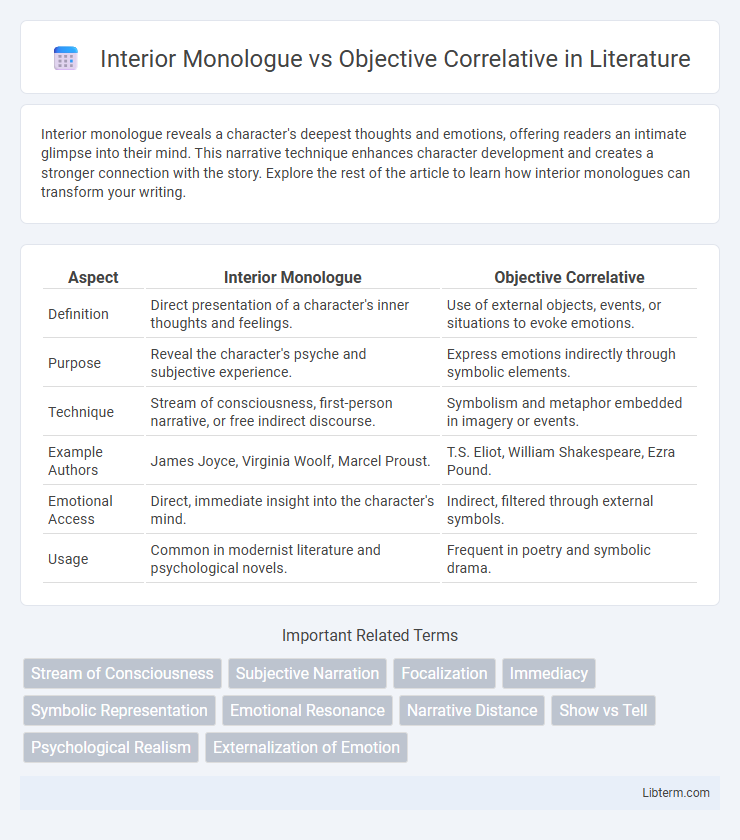Interior monologue reveals a character's deepest thoughts and emotions, offering readers an intimate glimpse into their mind. This narrative technique enhances character development and creates a stronger connection with the story. Explore the rest of the article to learn how interior monologues can transform your writing.
Table of Comparison
| Aspect | Interior Monologue | Objective Correlative |
|---|---|---|
| Definition | Direct presentation of a character's inner thoughts and feelings. | Use of external objects, events, or situations to evoke emotions. |
| Purpose | Reveal the character's psyche and subjective experience. | Express emotions indirectly through symbolic elements. |
| Technique | Stream of consciousness, first-person narrative, or free indirect discourse. | Symbolism and metaphor embedded in imagery or events. |
| Example Authors | James Joyce, Virginia Woolf, Marcel Proust. | T.S. Eliot, William Shakespeare, Ezra Pound. |
| Emotional Access | Direct, immediate insight into the character's mind. | Indirect, filtered through external symbols. |
| Usage | Common in modernist literature and psychological novels. | Frequent in poetry and symbolic drama. |
Introduction to Literary Techniques
Interior monologue captures a character's inner thoughts and emotions directly, revealing personal consciousness and psychological depth. Objective correlative uses external objects, situations, or events to symbolize and evoke specific emotions without explicit exposition. These literary techniques uniquely engage readers by either immersing them in subjective experience or presenting symbolic cues to interpret emotional states.
Defining Interior Monologue
Interior monologue is a narrative technique that captures a character's inner thoughts and emotions directly, providing readers with intimate access to the mind. This method reveals psychological depth by presenting unfiltered mental processes, often lacking external narration or commentary. Distinct from objective correlative, which uses symbolic objects or situations to evoke emotions indirectly, interior monologue immerses the audience in subjective cognitive experience.
Understanding Objective Correlative
Understanding objective correlative involves recognizing it as a literary device where a set of objects, situations, or events evoke specific emotions, contrasting with the interior monologue that explicitly reveals a character's thoughts. Objective correlative relies on symbolic external elements to indirectly communicate internal states, enhancing thematic depth and emotional resonance. This technique, popularized by T.S. Eliot, serves to create a concrete representation of abstract feelings, enabling readers to experience emotions through imagery rather than direct exposition.
Historical Evolution of Both Concepts
Interior monologue, first defined by psychologist William James in the late 19th century, evolved through modernist writers like James Joyce and Virginia Woolf who emphasized stream-of-consciousness techniques to reveal characters' inner thoughts. The objective correlative, coined by T.S. Eliot in the early 20th century, developed as a literary device to evoke emotion through a set of objects or events symbolizing a character's inner state without direct exposition. Both concepts emerged from shifting narrative strategies, moving from external descriptions to psychological depth and symbolic representation in response to changing literary and philosophical understandings of consciousness and expression.
Key Differences Between Interior Monologue and Objective Correlative
Interior monologue reveals a character's inner thoughts and emotions directly, providing intimate access to their mind. Objective correlative, by contrast, uses external objects, settings, or events to symbolically evoke a character's emotional state without explicit exposition. The key difference lies in interior monologue's direct psychological insight versus objective correlative's reliance on symbolic representation to communicate emotions.
Functions in Storytelling and Narrative
Interior monologue delves into a character's private thoughts and emotions, enabling readers to experience their psychological depth and internal conflicts directly. Objective correlative employs external objects, actions, or events to symbolically represent a character's feelings or themes, allowing storytellers to convey emotions indirectly through vivid imagery. These narrative techniques function to deepen emotional resonance, with interior monologue providing intimate access to the mind, while objective correlative evokes mood and meaning through symbolic associations.
Famous Examples in Literature
Interior monologue, exemplified by James Joyce's "Ulysses," unveils the protagonist's stream of consciousness, revealing intricate thoughts and emotions directly. In contrast, T.S. Eliot's use of objective correlative in "The Love Song of J. Alfred Prufrock" employs external objects and scenarios to evoke emotional states symbolically. Both techniques enrich literary expression by either internalizing subjective experience or externalizing emotion through symbolic representation.
Strengths and Limitations of Each Technique
Interior monologue excels at revealing a character's innermost thoughts and emotions, offering deep psychological insight and fostering reader empathy, but it can slow narrative pacing and overwhelm with excessive internal detail. Objective correlative provides a powerful method to evoke emotions through external symbols or events, enhancing thematic depth without direct exposition, yet it risks ambiguity if the connections between symbol and emotion are unclear or overly subtle. Balancing these techniques enables writers to create richly textured narratives that engage readers both intellectually and emotionally.
Choosing the Right Technique for Your Writing
Interior monologue offers a direct glimpse into a character's thoughts and emotions, making it ideal for deeply personal or psychological narratives. Objective correlative uses symbolic objects or situations to evoke emotions indirectly, enhancing subtlety and thematic depth. Selecting the right technique depends on your story's focus: use interior monologue for intimate character exploration and objective correlative for emotional resonance through imagery.
Conclusion: Impact on Reader Experience
Interior monologue immerses readers in a character's direct thoughts, creating a deep psychological connection that fosters empathy and emotional engagement. Objective correlative uses external symbols or objects to evoke emotions, enabling readers to infer feelings indirectly while maintaining narrative distance. The impact on reader experience varies as interior monologue offers intimacy and immediacy, whereas objective correlative encourages interpretative participation and subtle emotional resonance.
Interior Monologue Infographic

 libterm.com
libterm.com